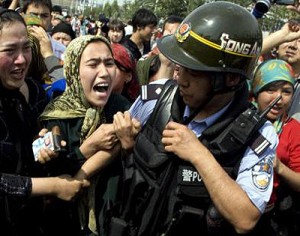Rise in Ethnic Violence in Uighur, China
Thursday, May 8th, 2014 4:14:39 by Jamshed Sindhu
You may see them in many Chinese cities outside Xinjiang leading restaurants offering delicious kebabs, fried rice dishes with carrot and lamb stews or with loaves of bread. Tricycles or selling a sweet pulp and very similar to almond nougat. Happy music playing in bars and nightclubs. They are the face of the Uighur migration within China. But the vast majority of Uighurs – about 10 million – live in Xinjiang Autonomous Region in western China, which borders Central Asia. Another 300,000 are in Kazakhstan, Uzbekistan and Kyrgyzstan. There are also communities in Turkey, Russia, the U.S., Germany and Sweden.
The Uighurs, one of the 55 minorities in China, where the majority ethnic group is the Han, representing about 91% of the 1,350 million inhabitants, Muslim and their language is of Turkic origin with Arabic alphabet.
The Xinjiang Uygur Autonomous Region – name officially has an area of 1.6 million square kilometers with a population of 22.6 million people, of which the Uighurs account for less than half – 47% – due to the efforts of the central government for decades to repopulate the region with members of the Han, which now account for 38 %.
Other groups living in Xinjiang are Kazakhs, Hui and Mongols. But they have controlled the political and economic life of this area of mountains and deserts, rich in gas and other natural resources, which is a major source of discontent among Uighurs.
Economic disparities and tensions between the two main ethnic groups have led to outbreaks of violence, which peaked in July 2009, when nearly 200 people – most of them – have died in several days of fighting in the capital, Urumqi.
In the twentieth century, there was twice in Xinjiang, briefly, a republic of East Turkestan.
After the victory of Mao Zedong ‘s Communists in the civil war in 1949, the People’s Liberation Army ended the Second East Turkestan Republic, and many were exiled Uighurs.
Beijing says the violence suffered periodically Xinjiang – and increasingly occurs more outside the region itself – is the work of religious and extremist terrorist connections abroad, seeking independence, including the Islamic Movement of East Turkestan (ETIM).
Washington included ETIM on its list of foreign terrorist organizations in 2002 after the September 11 attacks in the U.S., but later withdrew it.
Short URL: https://www.newspakistan.pk/?p=43726

















